By Marilou Audet, occupational therapist
The boutonniere deformity is probably the most insidious of finger deformities. Often mistaken for a sprain, this injury can evolve, without treatment, into a rigid and permanent deformity of the finger. The challenge: while the deformity is easy to recognize, once established, there can be a delay of several weeks—ranging from one week to three months—between the injury and the appearance of the deformity.
The boutonniere deformity results from a rupture of the central slip of the extensor tendon. The intact lateral slips insert on the distal phalanx. They gradually luxate palmarly from the proximal interphalangeal joint and exert traction on the distal interphalangeal joint. This results in flexion of the proximal interphalangeal joint and hyperextension of the distal interphalangeal joint.
Causes
Mostly, these injuries are related to trauma to the dorsum of the proximal interphalangeal joint, resulting from tendon rupture, dislocation, or fracture. They are also encountered in contact or ball sports, as well as in individuals with rheumatoid arthritis.

Elements that suggest a boutonniere deformity
- Trauma history
- Localized swelling at the PIP joint
- Pain on palpation of the dorsum of the PIP joint
- Inability to achieve full active extension of the PIP joint
Conservative treatment
Early intervention has proven to be the most effective treatment in preventing joint contractures, such as boutonniere deformities. Non-surgical treatment includes:
- When the PIP joint flexion contracture is reducible: Constant immobilization for 6 weeks with an extension splint for the PIP joint. Flexion exercises for the DIP joint, with the PIP joint in extension, are taught to encourage repositioning of the lateral bands.
- When the PIP joint flexion contracture is rigid: It must first be corrected using serial casts or an extension splint, combined with a flexibility exercise program for the DIP joint. Once the flexion contracture is corrected, the 6-week immobilization period can begin.
- Close supervision during treatment is encouraged to ensure optimal recovery and to support the gradual progression of exercises aimed at optimizing active extension of the PIP joint.
- It is also crucial to begin weaning off the splint gradually to prevent recurrence of the deformity.
References
1. Haerle M, Lotter O, Mertz I, Buschmeier N. [The traumatic boutonnière deformity]. Orthopade. Dec 2008;37(12):1194-201
2. Likes, R. (2010) Boutonniere Deformity. Retrieved April 19, 2011, from http://emedicine.medscape.com/article/1238095-overview#showall
3. Glasgow C, Tooth L, Fleming J. Mobilizing the Stiff Hand: Combining Theory and Evidence to Improve Clinical Outcomes. J Hand Ther. 2010;23:392-401.
4. Matzon J, Bozentka D. Extensor Tendon Injuries. JHS. 2010;35A:854-861
5. Wilton JD. Biomechanical principles of design, fabrication and application. In:Wilton J (ed). Hand Splinting. London, UK: WB Saunders Company Ltd, 1997. pp. 31–9.
6. Colditz JC. Therapist’s management of the stiff hand. In: Hunter JM, Mackin EJ, Callahan AD, Skirven TM, Schneider LH, Osterman AL (eds). Rehabilitation of the Hand and Upper Extremity. 5th ed. St Louis: Mosby, 2002. pp. 1021–49.
